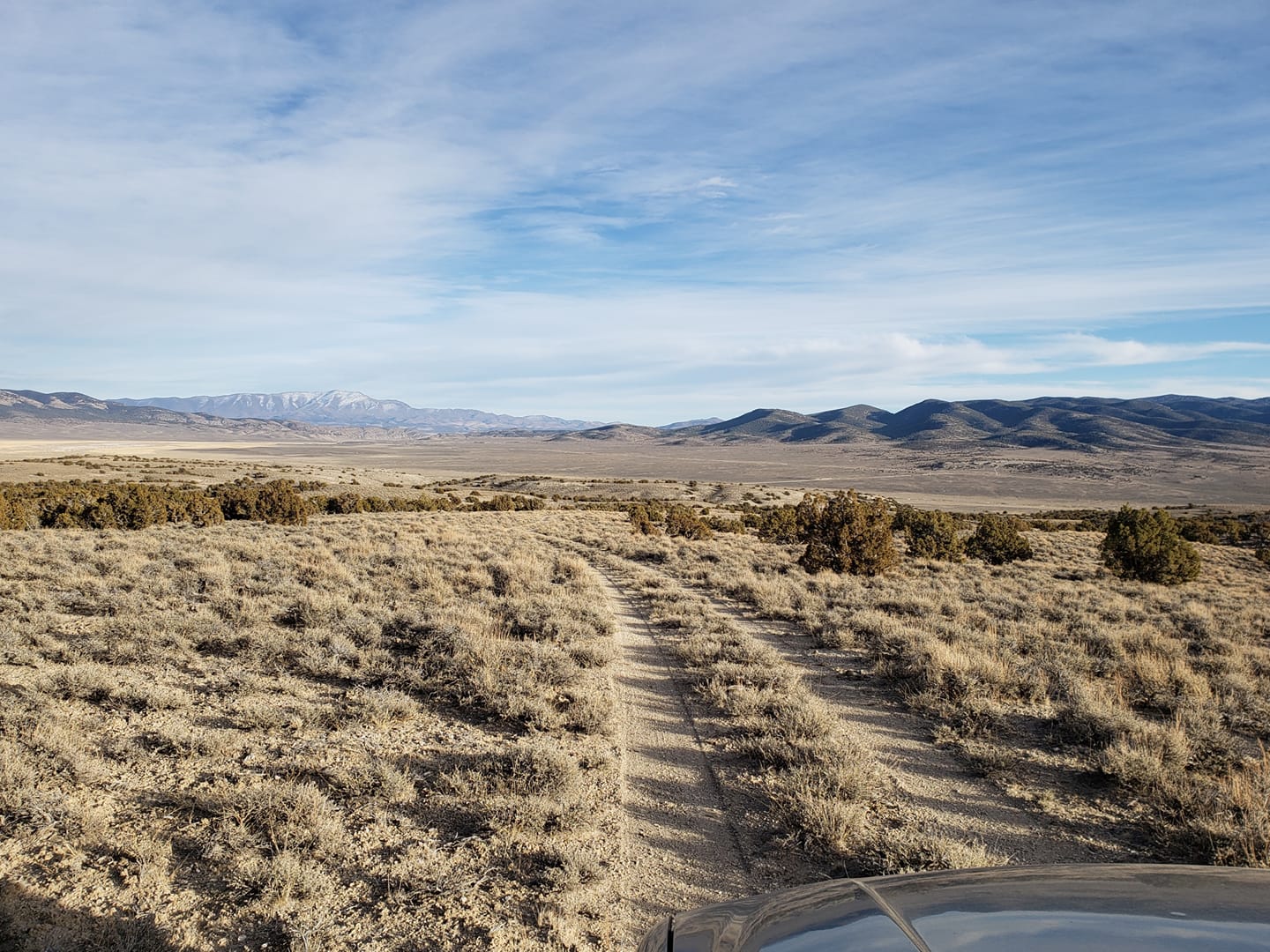Reflections in the Paleozoic, Eureka, Nevada
*** GENERAL MOLY NEWS ***
General Moly Announces Results of Annual Meeting (6/14/2013)
Mt. Hope construction continues despite financial issues (by Marianne Kobak McKown, Elko Daily Free Press, 5/31/2013)
General Moly Provides Finance Update (5/15/2013)
General Moly Quarterly Report (Released 5/3/2013)
A very detailed General Moly briefing for investors on the status of Mt. Hope molybdenum project:
General Moly Investor Presentation
See earlier March 22 and March 29 reports for a full chronology of the $665 million Hanlong loan suspension.
Latest Nevada Gas Prices (click this link)
My latest Kitco commentary: Oil, Copper & $1,100 Gold - The Seven Year Itch (07/22/2013)
Paintings by Mariana Titus, The Three Anas & The Three Moon Anas, are presently at Lafitte Guest House & Gallery, New Orleans
Friday's morning prices...
Below are the morning prices used for today's analysis:
COMEX Gold price = $1,324.1/oz (August contract most active)
COMEX Silver = $19.935/oz (September)
COMEX Copper = $3.1110/lb (September)
NYMEX WTI crude = $105.01 (September)
ICE Brent crude = $107.13/bbl (September)
Eureka Miner’s Gold Value Index© (GVI) = 88.97 (gold value is trading at a discount to oil and near fair value relative to copper)
Value Adjusted Gold Price© (VAGP) = $1,243.5/oz
COMEX - VAGP = $80.6/oz; gold is trading at a declining premium to key commodities.
General Moly (GMO) = $1.94 down 2.02%
Barrick Gold (ABX) = $17.47 down 0.23%
Newmont Mining (NEM) = $29.55 down 1.27%
Gold has had a good week above the $1,300-level but has retreated some today, down $4.7 to $1,324.1 per ounce. Please checkout my input to the weekly Kitco News Gold Survey (below) and most recent Kitco News commentary for my latest thoughts, Oil, Copper & $1,100 Gold - The Seven Year Itch.
This morning we continue our summer story about Mt. Hope...
Mt. Hope - A Journey in Space and Time (Part II, From Supernovae to Earthly Minerals)
A multi-part series that circumnavigates the Mt. Hope molybdenum mine site on Eureka County back roads and highways. Starting with the creation of molybdenum in the early universe, this journey will cover the geology of the area as well as its colorful history. There will be two trips, Loop#1 and #2, which include ranches of early settlers, a portion of the Pony Express Trail, a challenging section of the old Eureka-Palisade Railroad and a mine site tour. If you'd like to visit Mt. Hope, please make arrangements beforehand with Zach Spencer, General Moly's Director of Media Relations. Like any mine site, there are both security and safety concerns at Mt. Hope, but Zach and the Mt. Hope team do everything possible to accommodate public interest in their project. You can contact Zach by e-mail: zspencer@generalmoly.com
From Supernovae to Earthly Minerals
Since traveling the Mt. Hope loops is a journey through
time as well as interesting places, we began our story last week by describing
how molybdenum and other elements heavier than iron were formed and distributed throughout the universe by massive stellar explosions called
supernovae.
Some four billion years ago all this cosmic gas and metallic
shrapnel came together to form our planet earth. The swirling heated mixture
cooled and over time metals like molybdenum were distributed unevenly about the
earth's crust for reasons we'll examine later. Northern Nevada has the great
fortune to have inherited more than her fair share of these minerals as
geologists like to call metals and other inorganic substances found in their
earthly state.
For example, Mt. Hope will be mined for molybdenite which is
a mineral of molybdenum disulfide comprised of molybdenum in combination with
sulfur. Minerals are characterized, in part, by atomic structure - in this case a sheet
of molybdenum atoms sandwiched between sheets of sulfur atoms. The moly-sulfur bonds
are strong, but the interaction between the sulfur atoms at the top and bottom
of separate layers is weak, resulting in easy slippage. This gives molybdenite
a lubricating quality as a consequence of its layered structure (if you’re a gearhead,
think of that the next your hands are black with moly grease!).
Although useful in lubricants, molybdenum is used primarily
as an alloy agent in steel manufacturing.
When added to steel, moly enhances steel strength, resistance to
corrosion, and extreme temperature performance. Our gearhead friend with the
blackened hands will tell you that 4130 chrome moly tubing has been used in
dragsters for decades where maximum strength at minimum weight is key. Within
the chemical industry, moly also has an important role in the petroleum
refining process, acting as a cracking agent to remove sulfur from liquid
fuels - again, the affinity of moly for sulfur.
The process that brought many minerals of economic interest
to the surface in Northern Nevada occurred in two major steps: mountain
building in the Paleozoic era (hundreds of millions of years ago) followed by
faulting and volcanism during the more recent Miocene (tens of millions of
years ago) creating features like the Northern Nevada Rift (NNR).
Located on the eastern border the NNR, Mt. Hope became an amazing warehouse of rare
stellar gifts brought to earth’s surface by our planet’s most powerful physical
processes. It is an ageless museum of exotic minerals which include not only
vast deposits of molybdenum but possibly even rhenium, one of the rarest
elements on our planet - even more rare than gold. Nickel-based superalloys of
rhenium are used in the combustion chambers, turbine blades, and exhaust
nozzles of jet engines.
Molybdenum and valuable by-products like rhenium have
critical and strategic applications whose production will enhance the future economic
diversity of Eureka County. General Moly estimates that Mt. Hope will have a
44-year mine life - that's a lot of stardust to process, pardner!
We’ll dig deeper into the geology that supported molybdenum’s
concentration at Mt. Hope as we travel around the mountain’s base on our two different
loops. Let’s do a little trip prep first.
The Atlas of Eureka County
The ole Colonel is big on maps. Google Maps is terrific for
trip planning and we’ll use the satellite imagery in a later episode to locate
the old Eureka-Railroad Railroad rail bed at Garden Pass. Google Earth will allow
you to fly in 3-D around Mt. Hope and follow the roads of both Loop #1 and
Loop#2.
As cool as Google is, there is no substitute for a good
paper map in the back country of northern Nevada where cellphone and internet access
are spotty or nonexistent. If you've ever had to hike out after high-centering
your 4WD in spring mud, you can testify to the value of a paper map -
especially if you’re in unfamiliar territory.
Fortunately, a quick trip to the historic Eureka Courthouse will
fix you up. In 2004, Eureka County commissioned an extensive aerial survey of
the county to enhance the data developed by their GIS Department. The resulting
maps are part of the “Atlas of Eureka County” on sale for $25 at the County Assessor’s office (door to the left of the main entrance on Main Street). The Atlas
is a compendium of detailed relief maps showing main routes, county roads (and
numbers), non-county roads and more than a few cow trails. Importantly, it
identifies all of the historic sites that will be visited during this summer series. Start
packing, we’ll start Mt. Hope Loop #1 bright n’ early next Friday.
Spot moly oxide prices have fallen far deeper into the $9 per pound-level. Here are the latest numbers compliments of moly benchmark miner Thompson Creek (TC):
Metals Week Weekly Average: US$9.25 as of July 22, 2013 (updated weekly)
Ryan's Notes Average: US$9.15 as of July 23, 2013 (updated twice weekly)
The London Metal Exchange (LME) futures contracts have thankfully returned above spot prices this week. Remember that this is a thinly traded futures market and contract prices reflect developments in Europe probably more than the global spot price averages above.
3-month seller's contract $20,500 per metric ton ($9.29 per pound)
15-month seller's contract $21,200 per metric ton ($9.62 per pound)
The Colonel's Gold, Silver & Copper Prices for Next Week
Here is my weekly input to the weekly Kitco Gold Survey:
07/26/2013
(10:28 AM CT)
Q. Where
do you see gold’s price headed next week, up, down or unchanged?
A. Up. My target
price is $1,334 per ounce; the 50% retracement from June’s low to May’s high.
Q.
Why?
A.
Gold had another good week buoyed a weaker US dollar and rumors about dovish
candidates for Chairman Bernanke’s replacement next year. News today that
Russia and some emerging market central banks had bought gold in June was also supportive. Although
gold has pulled back some this morning, the yellow metal rose in U.S. dollar
terms and gained value relative to both copper and oil (see table below). However,
until the relation of gold and U.S. equities changes, I continue to be bearish
on the near term prospects of the yellow metal although the onset of the summer
doldrums will likely preclude any serious price declines. The longer term
prospects remain positive.
The
S&P 500 made a new all-time record Monday but is likely to close down for
the week. Comex gold has recovered over $115 per ounce from its July 5 low. The
relation between the two is illustrated by a plot of the gold-to-S&P 500
ratio, or AUSP:
For
$1,334 per ounce gold we can expect to see silver in a statistically bounded range*
of $19.5-$20.7 per ounce; and copper in a range of $3.08-$3.35 per pound. Silver
is expected to have a neutral bias with respect to a range mean of $20.135 per
ounce; copper, a negative bias with respect to a mean of $3.2141 per pound.
(*
+/- 2-standard deviations, 1-month basis)
This
week, gold has gained dollar price and value relative to oil and copper; oil
has lost value relative to copper. The chart below is a week-over-week
valuation matrix (Read the chart as “1 unit of row A buys X units of column B”;
for example,”1 ounce of gold buys 425.6 pounds of copper. Percentages are
change from last Friday’s closing numbers):
Since
last November, gold has experienced bearish value destruction not only in U.S.
dollar terms but value relative to oil and copper. Recently, gold has regained
some of its value lost to the red metal:
There
is a danger that gold may re-enter $1,100 territory as explained in my July 22 Kitco
commentary.
Although I remain long-term bullish on gold:
As measured by the Eureka Miner’s Gold Value Index
(GVI, Ref 1), the value of gold relative to global commodities copper and oil and
companion metal silver is 88.97, below the key-100 level but above the 1-month
moving average of 86.25. The 2012 high was 103.73 on Nov. 13.
Cheers,
Colonel Possum
Photos by Mariana Titus
Please checkout bayoutales.com for books and book orders
Paintings by Mariana Titus, The Three Anas, are presently at Lafitte Guest House & Gallery, New Orleans
Write Colonel Possum at colonelpossum@gmail.com for answers to your questions or to request e-mail updates on the market






+6-5+in.jpg)


.JPG)




.jpg)

+6-5in.jpg)
+wk.jpg)
+nov+09.jpg)




+4-8in.jpg)













.png)



.jpg)


.jpg)